Spatial Characteristics of Population Activities in Suburban Villages Based on Cellphone Signaling Analysis
Abstract
1. Introduction
2. Literature Review
3. Materials and Methods
3.1. Data Source
3.2. Analysis Framework
3.3. Data Processing and Analysis Methods
3.3.1. Positioning Method in Rural Area
3.3.2. Classification and Identification of Population Attributes
3.3.3. Data Processing and Indicator Construction
3.3.4. Spatial Clustering Method
4. Analysis Results
4.1. Suburban Rural Population Attributes
4.1.1. Staying Purpose
4.1.2. Regional Population Distribution
4.1.3. Population Age Composition
4.2. Characteristics of Rural Resident Activities
4.2.1. Overall Characteristics
4.2.2. Temporal and Spatial Distribution Characteristics
4.2.3. Characteristics of Spatial Activities
4.3. Analysis of Suburban Rural Space
5. Conclusions and Discussion
5.1. Discussion
5.1.1. Application of Cellphone Signaling Location in Suburban Villages
5.1.2. Application in Town and Village Planning
5.1.3. Application in Planning Evaluation
5.1.4. Application of Rural Vitality Intensity
5.2. Conclusions
Author Contributions
Funding
Conflicts of Interest
References
- Chen, Y.Q. Discussion of rural-urban fringe and Its characteristics and functions. Econ. Geogr. 1996, 3, 27–31. [Google Scholar] [CrossRef]
- Yang, T.; Pan, H.; Hewings, G.; Jin, Y. Understanding urban sub-centers with heterogeneity in agglomeration economies—Where do emerging commercial establishments locate? Cities 2019, 86, 25–36. [Google Scholar] [CrossRef]
- Qu, D.Y.; Zhuang, J.S.; Chen, X.F.; Hao, L. Research on the impact of suburban urbanization on traffic in central area. In Proceedings of the 2012 3rd International Conference on Digital Manugacture Automatic ICDMA, Guilin, China, 31 July–2 August 2012; pp. 711–715. [Google Scholar]
- Pan, Y.; Hong, L. Out of the Plight of “Passive Urbanization” by Midwestern Metropolitan Suburban Areas in China. Urban Plan. Forum 2013, 4, 42–48. [Google Scholar] [CrossRef]
- Ramachandraiah, C.; Srinivasan, R. Special economic zones as new forms of corporate land grab: Experiences from India. Development 2011, 54, 59–63. [Google Scholar] [CrossRef]
- Lin, J.; Cai, J.; Han, Y.; Liu, J. Identifying the conditions for rural sustainability through place-based culture: Applying the CIPM and CDPM models into Meibei ancient village. Sustainability 2017, 9, 1334. [Google Scholar] [CrossRef]
- Qiao, F.; Ai-Jun, G. Radiation Power of National New Area and Its Formation Mechanism. Reform Econ. Syst. 2018, 5, 4–51. [Google Scholar]
- Li, J.; Webster, D.; Jianming, C. Manufacturing-led peri-urbanisation in central China: The case of Wuhan’s Dongxihu District. Int. Dev. Plan. Rev. 2018, 40, 175–202. [Google Scholar] [CrossRef]
- Liu, J.; Xun, C. Nation New District Policy: Reflection on the Implementation Deviation. Urban Dev. Stud. 2017, 24, 18–25. [Google Scholar] [CrossRef]
- Xu, D.; Hou, G. The spatiotemporal coupling characteristics of regional urbanization and its influencing factors: Taking the Yangtze River Delta as an example. Sustainability 2019, 11, 822. [Google Scholar] [CrossRef]
- Chen, M.; Liu, W.; Lu, D. Challenges and the way forward in China’s new-type urbanization. Land Use Policy 2016, 55, 334–339. [Google Scholar] [CrossRef]
- Yao, S.M.; Zhang, P.Y.; Yu, C.; Li, G.Y.; Wang, C.X. The Theory and Practice of New Urbanization in China. Sci. Geogr. Sin. 2014, 34, 641–647. [Google Scholar] [CrossRef]
- Søholt, S.; Stenbacka, S.; Nørgaard, H. Conditioned receptiveness: Nordic rural elite perceptions of immigrant contributions to local resilience. J. Rural Stud. 2018, 64, 220–229. [Google Scholar] [CrossRef]
- Sanders, S.R.; Brown, D.L. The Migratory Response of Labor to Special Economic Zones in the Philippines, 1995–2005. Popul. Res. Policy Rev. 2012, 31, 141–164. [Google Scholar] [CrossRef]
- Chen, Y.; Rosenthal, S.S. Local amenities and life-cycle migration: Do people move for jobs or fun? J. Urban Econ. 2008, 64, 519–537. [Google Scholar] [CrossRef]
- Wang, P.; Elliott, A.L.; Chen, X.; Yu, B.; Gong, J. Social Capital Associated with Quality of Life Mediated by Employment Experiences: Evidence from a Random Sample of Rural-to-Urban Migrants in China. Soc. Indic. Res. 2017, 139, 327–346. [Google Scholar] [CrossRef]
- Liu, C.Y.; Chen, J.; Li, H. Linking migrant enclave residence to employment in urban China: The case of Shanghai. J. Urban Aff. 2018, 40, 1–17. [Google Scholar] [CrossRef]
- Dadashpoor, H.; Azizi, P.; Moghadasi, M. Land use change, urbanization, and change in landscape pattern in a metropolitan area. Sci. Total Environ. 2019, 655, 707–719. [Google Scholar] [CrossRef] [PubMed]
- Liu, Q.Q.; Wu, K.N.; Pan, Y.C.; Zhao, H.F.; Ma, J.H.; Guo, A.Q. Spatial Pattern of Land Use in Metropolitan Suburban Area:A Case Study of Daxing District in Beijing, China. J. Ecol. Rural Environ. 2014, 30, 174–181. [Google Scholar]
- García-Ayllón, S. Rapid development as a factor of imbalance in urban growth of cities in Latin America: A perspective based on territorial indicators. Habit. Int. 2016, 58, 127–142. [Google Scholar] [CrossRef]
- Ahas, R.; Aasa, A.; Silm, S.; Tiru, M. Daily rhythms of suburban commuters’ movements in the Tallinn metropolitan area: Case study with mobile positioning data. Transp. Res. Part Emerg. Technol. 2010, 18, 45–54. [Google Scholar] [CrossRef]
- Hoteit, S.; Secci, S.; Sobolevsky, S.; Pujolle, G.; Ratti, C. Estimating real human trajectories through mobile phone data. Proc. IEEE Int. Conf. Mob. Data Manag. 2013, 2, 148–153. [Google Scholar]
- Niu, X.Y.; Wang, Y.; Ding, L. Measuring urban system hierarchy with cellphone signaling. Planners 2017, 33, 50–56. [Google Scholar] [CrossRef]
- Goodspeed, R.; Yan, X.; Hardy, J.; Vinod Vydiswaran, V.G.; Berrocal, V.J.; Clarke, P.; Romero, D.M.; Gomez-Lopez, I.N.; Veinot, T. Comparing the data quality of global positioning system devices and mobile phones for assessing relationships between place, mobility, and health: Field study. J. Med. Internet Res. 2018, 20. [Google Scholar] [CrossRef]
- Setiadi, Y.; Uluwiyah, A. Improving data quality through big data: Case study on big data-mobile positioning data in Indonesia tourism statistics. In Proceedings of the International Workshop on Big Data & Information Security, IEEE, Jakarta, Indonesia, 18–19 October 2017. [Google Scholar] [CrossRef]
- Ahas, R.; Aasa, A.; Mark, Ü.; Pae, T.; Kull, A. Seasonal tourism spaces in Estonia: Case study with mobile positioning data. Tour. Manag. 2007, 28, 898–910. [Google Scholar] [CrossRef]
- Jia, Y.; Ge, Y.; Ling, F.; Guo, X.; Wang, J.; Wang, L.; Chen, Y.; Li, X. Urban land use mapping by combining remote sensing imagery and mobile phone positioning data. Remote Sens. 2018, 10, 446. [Google Scholar] [CrossRef]
- Niu, X.Y.; Ding, L.; Song, X.D. Understanding urban spatial structure of Shanghai central city based on mobile phone data. China City Plan. Rev. 2014, 6, 61–67. [Google Scholar] [CrossRef]
- Calabrese, F.; Colonna, M.; Lovisolo, P.; Parata, D.; Ratti, C. Real-time urban monitoring using cell phones: A case study in rome. IEEE Trans. Intell. Transp. Syst. 2011, 12, 141–151. [Google Scholar] [CrossRef]
- Reades, J.; Calabrese, F.; Ratti, C. Eigenplaces: Analysing cities using the space—Time structure of the mobile phone network. Environ. Plan. Plan. Des. 2009, 36, 824–836. [Google Scholar] [CrossRef]
- Wang, D.; Zhu, C.S.; Xie, D.C. Research on intra-city employment mobility in Shanghai: Based on cell phone data. Chin. J. Popul. Sci. 2016, 1, 80–89. [Google Scholar]
- Ahas, R.; Silm, S.; Saluveer, E.; Järv, O. Modelling home and work locations of populations using passive mobile positioning data. Lect. Notes Geoinf. Cartogr. 2009, 301–315. [Google Scholar] [CrossRef]
- Niu, X.Y.; Ding, L.; Song, X.D. Analyzing suburban new town development in Shanghai from the perspective of jobs-housing spatial relationship. City Plan. Rev. 2017, 41, 47–53. [Google Scholar] [CrossRef]
- Zhong, W.J.; Wang, D.; Xie, D.C.; Yan, L.X. Dynamic characteristics of Shanghai’s population distribution using cell phone signaling data. Geogr. Res. 2017, 36, 972–984. [Google Scholar] [CrossRef]
- Wang, D.; Wang, C.; Xie, D.C.; Zhong, W.J.; Wu, M.; Zhu, W.; Zhou, J.P.; Li, Y. Comparison of Retail Trade Areas of Retail Centers with Different Hierarchical Levels: A Case Study of East Nanjing Road, Wujiaochang, Anshan Road in Shanghai. Urban Plan. Forum 2015, 50–60. [Google Scholar] [CrossRef]
- Zhong, W.J.; Wang, D. Urban space study based on the temporal characteristics of residents’ behavior. Prog. Geogr. 2018, 37, 1106–1118. [Google Scholar] [CrossRef]
- Loibl, W.; Toetzer, T. Modeling growth and densification processes in suburban regions—Simulation of landscape transition with spatial agents. Environ. Model. Softw. 2003, 18, 553–563. [Google Scholar] [CrossRef]
- Wang, Y.Z. Research on Urban Spatial Vitality Characteristic Evaluation and Internal Mechanism of Shanghai Central City Based on Mobile Phone Signaling Data; Southeast University: Nanjing, China, 2017. [Google Scholar]
- Yang, F. Traffic OD data collection based on cellphone location technology. Syst. Eng. 2007, 1, 42–48. [Google Scholar] [CrossRef]
- Ran, B. Use of cellphone data in travel survey and transportation planning. Urban Trans. China 2013, 11, 72–81. [Google Scholar] [CrossRef]
- Feihu, Z. A Weighted Iterative Centroid Localisation Algorithm for Cellular Base Station. Comput. Appl. Softw. 2013, 30, 1–3, 61. [Google Scholar] [CrossRef]
- Xiaoyong, T.; Tao, Z.; Baichuan, L.U. Analysis of Wide Range Population Flow Analysis Based on Mobile Phone Signaling. J. Chongqing Jiaotong Univ. 2017, 36, 82–87, 109. [Google Scholar] [CrossRef]
- Li, P.F. Detecting the Spatial Characteristics of Urban Employment Using Mobile Phone Signaling Data: A Case Study of Shenyang City. Geomat. World 2019, 26, 25–30. [Google Scholar]
- Bodenhofer, U.; Kothmeier, A.; Hochreiter, S. Apcluster: An R package for affinity propagation clustering. Bioinformatics 2011, 27, 2463–2464. [Google Scholar] [CrossRef]
- Reades, J.; Calabrese, F.; Sevtsuk, A.; Ratti, C. Cellular Census: Explorations in Urban Data Collection. IEEE Perv. Comput. 2007, 6, 30–38. [Google Scholar] [CrossRef]
- Pei, T.; Sobolevsky, S.; Ratti, C.; Shaw, S.L.; Zhou, C.H. A new insight into land use classification based on aggregated mobile phone data. Int. J. Geogr. Inform. Sci. 2014, 28, 1988–2007. [Google Scholar] [CrossRef]
- Wang, W.T.; Wu, Y.L.; Tang, C.Y.; Hor, M.K. Adaptive density-based spatial clustering of applications with noise (DBSCAN) according to data. Proc. Int. Conf. Mach. Learn. Cybern. 2015, 1, 445–451. [Google Scholar] [CrossRef]
- Zhang, S.Z.; Yang, R.; Cheng, X.N.; Li, P.H. Coarse-grained parallel AP clustering algorithm based on intra-class and inter-class distance. J. Cent. China Normal Univ. 2018, 52, 781–787. [Google Scholar] [CrossRef]
- Wang, L.L. Rail Transit Passenger Flowtravel Information Extraction Andanalysis Method Based on Cellular Data; Southwest Jiaotong University: Chengdu, China, 2015. [Google Scholar]
- Miao, Z. Research on Data Cleaning Mining Jobs and Residential Locations Based on Mobile Phone Signaling Data; Southwest Jiaotong University: Chengdu, China, 2017. [Google Scholar]
- Xiao-Han, Y.U.; Dong, W. Study on city express delivery area division based on constrained K-means clustering algorithm. J. Harbin Univ. Comm. 2016, 32, 631–634, 640. [Google Scholar] [CrossRef]
- Liao, K. Rail Study on the relevance between Trip Characteristics and Real Estate Price based onMobile Signaling Data; Southwest Jiaotong University: Chengdu, China, 2018. [Google Scholar]
- Mu, T. Resident Travel Characteristics Analysis and Recommendation Based on Mobile Signaling Data; Southwest Jiaotong University: Chengdu, China, 2015. [Google Scholar]
- Weiqing, C.; Yanhong, L.U. Adaptive clustering algorithm based on maximum and minimum distances, and SSE. J. Nanjing Univ. Posts Telecommun. 2015. [Google Scholar] [CrossRef]
- Gornitz, N.; Lima, L.A.; Muller, K.R.; Kloft, M.; Nakajima, S. Support Vector Data Descriptions and k-Means Clustering: One Class? IEEE Trans. Neural Netw. Learn. Syst. 2018, 29, 3994–4006. [Google Scholar] [CrossRef]
- Xi, L.; Jun, W.; Man-Li, H.E. Evaluating the potential of stock land development in Shanghai based on big data. Shanghai Land Resour. 2017, 38, 14–20. [Google Scholar] [CrossRef]
- Long, F.J.; Shi, L.; Peng, Z.Y.; Yang, J.F.; Zhang, S. City Park Service Evaluation Based on Mobile Signaling Data. Urban Probl. 2018, 6, 88–92. [Google Scholar] [CrossRef]
- Guangjing, X. Re-Understanding of The Development of State-Level New Area Based on the National Strategic Perspective. City Plan. Rev. 2018, 42, 16–20. [Google Scholar] [CrossRef]
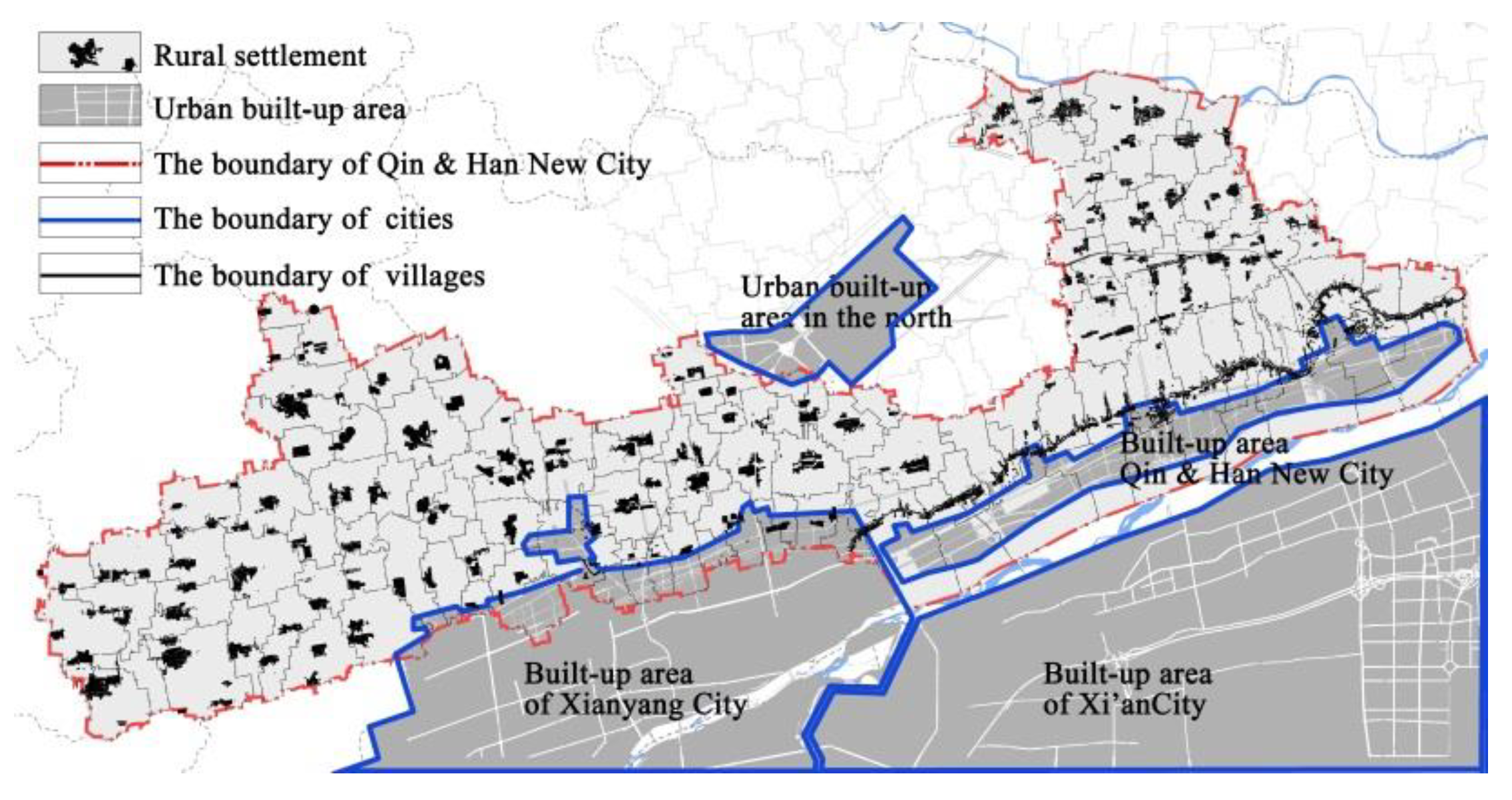

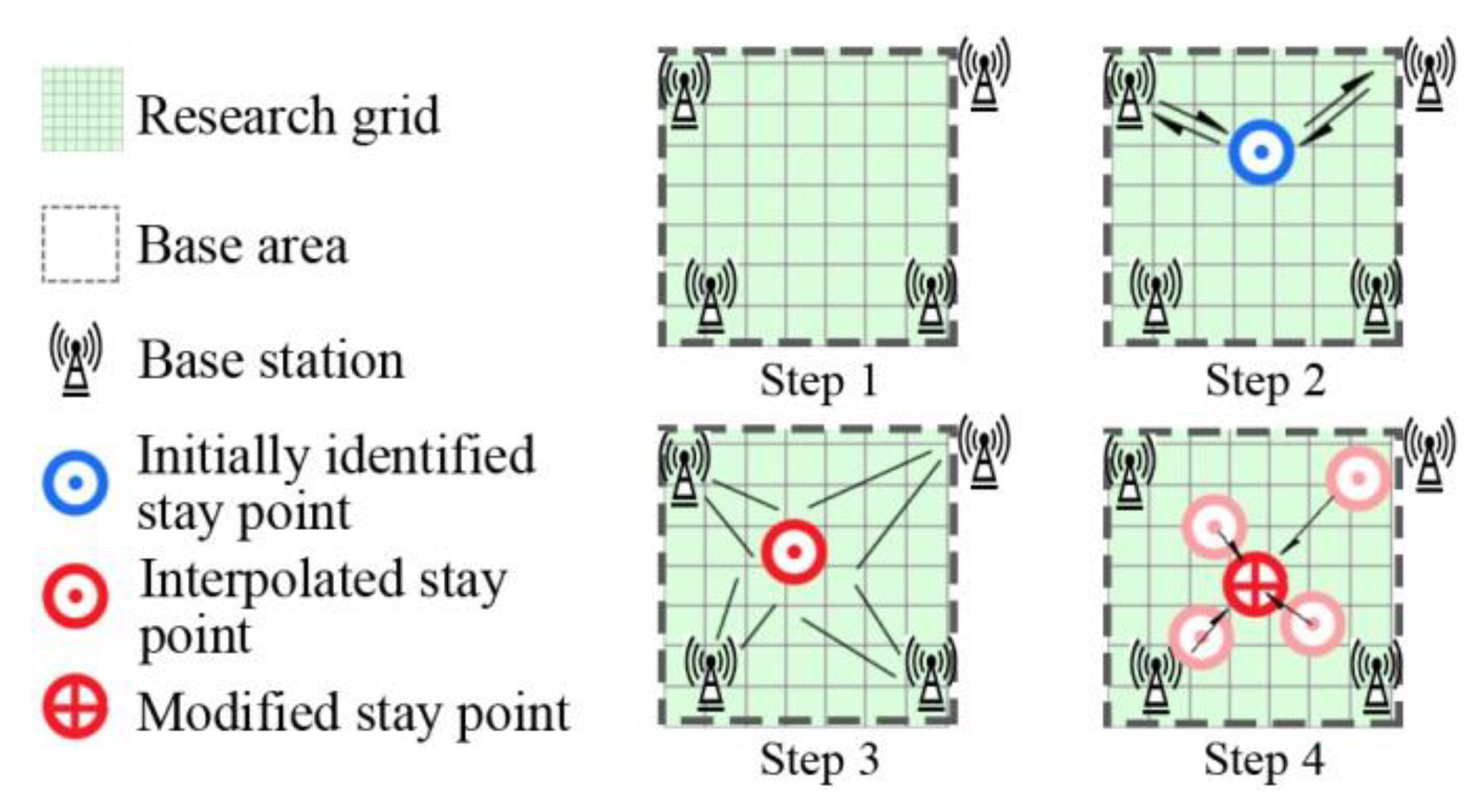
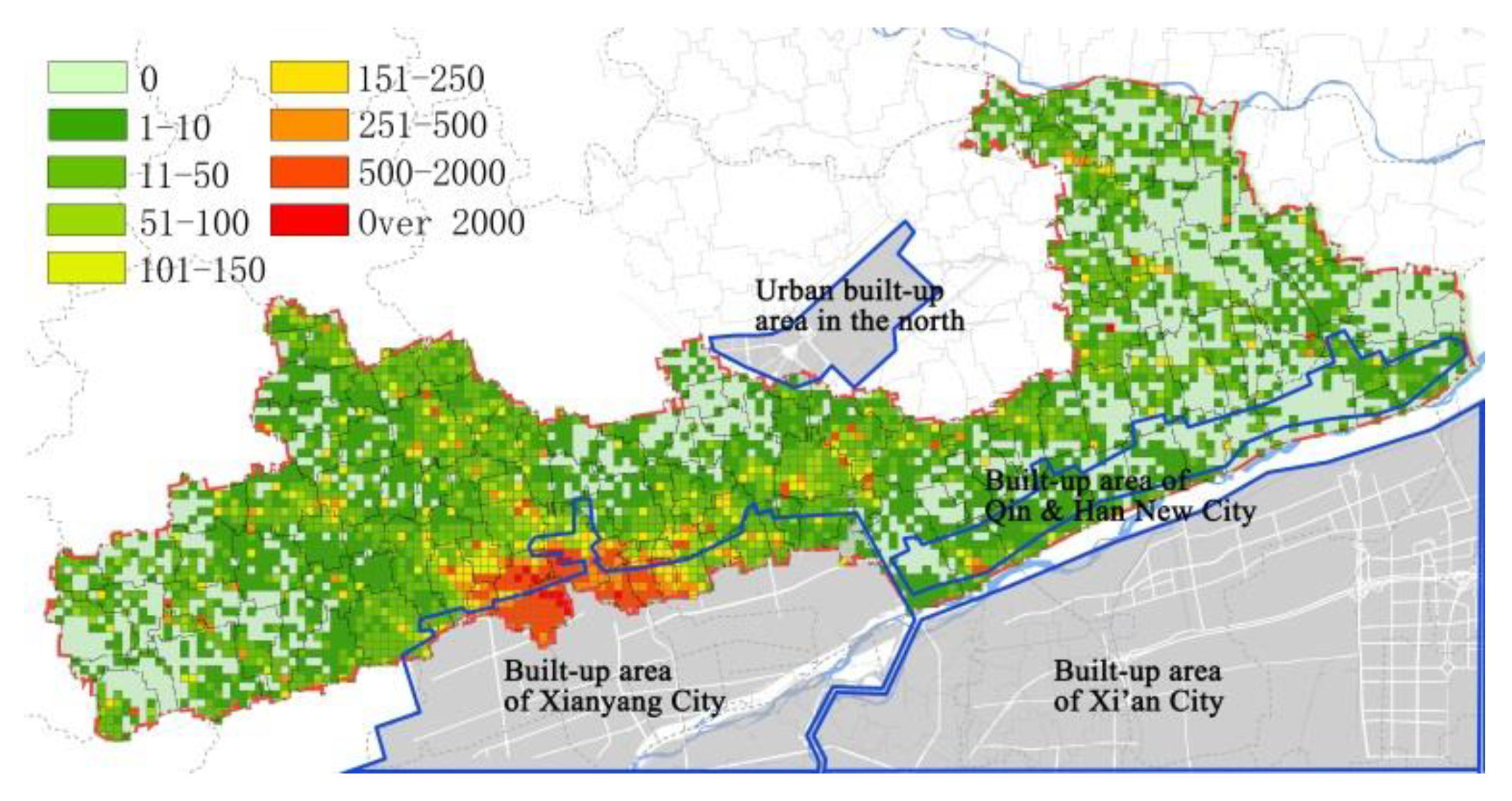
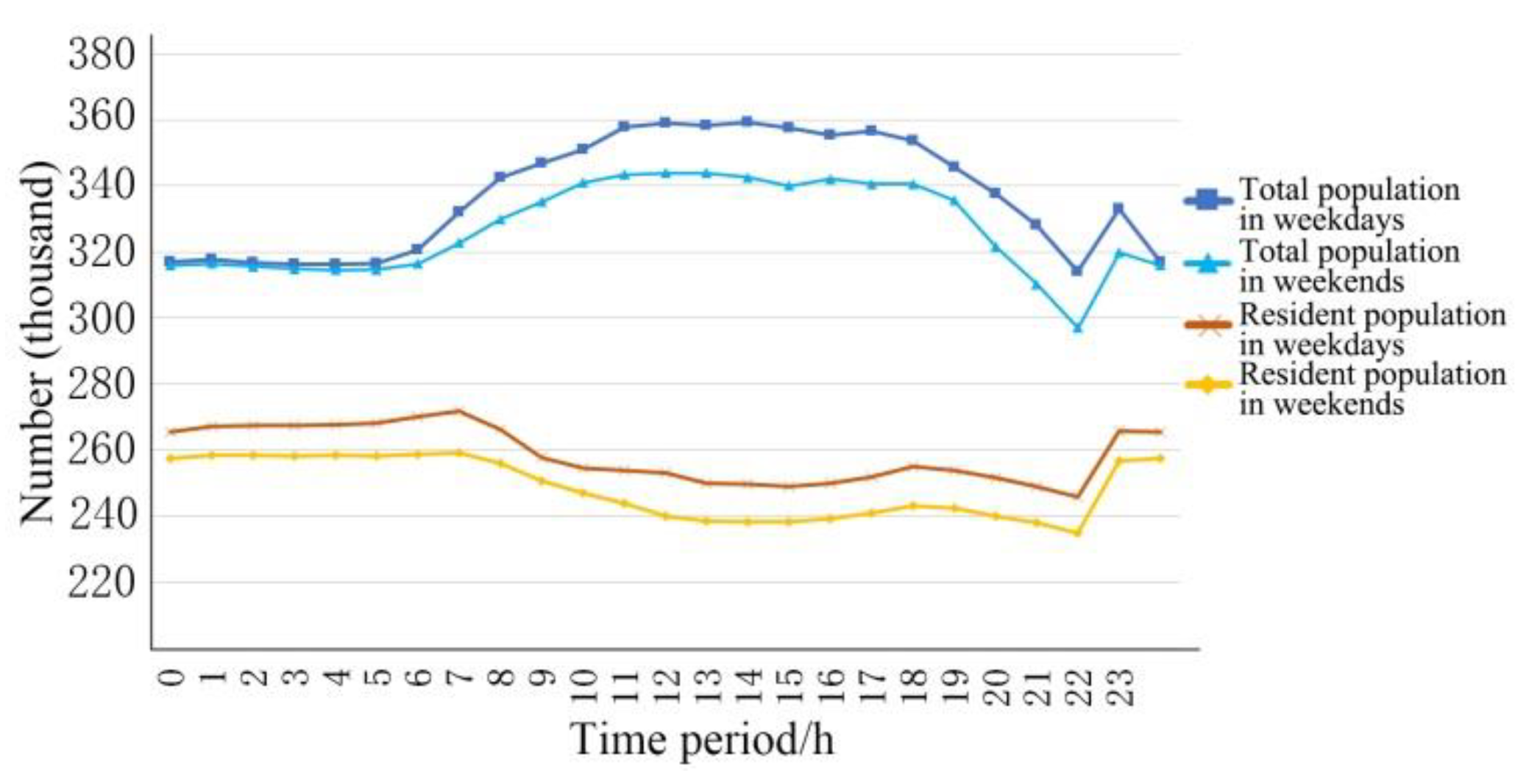
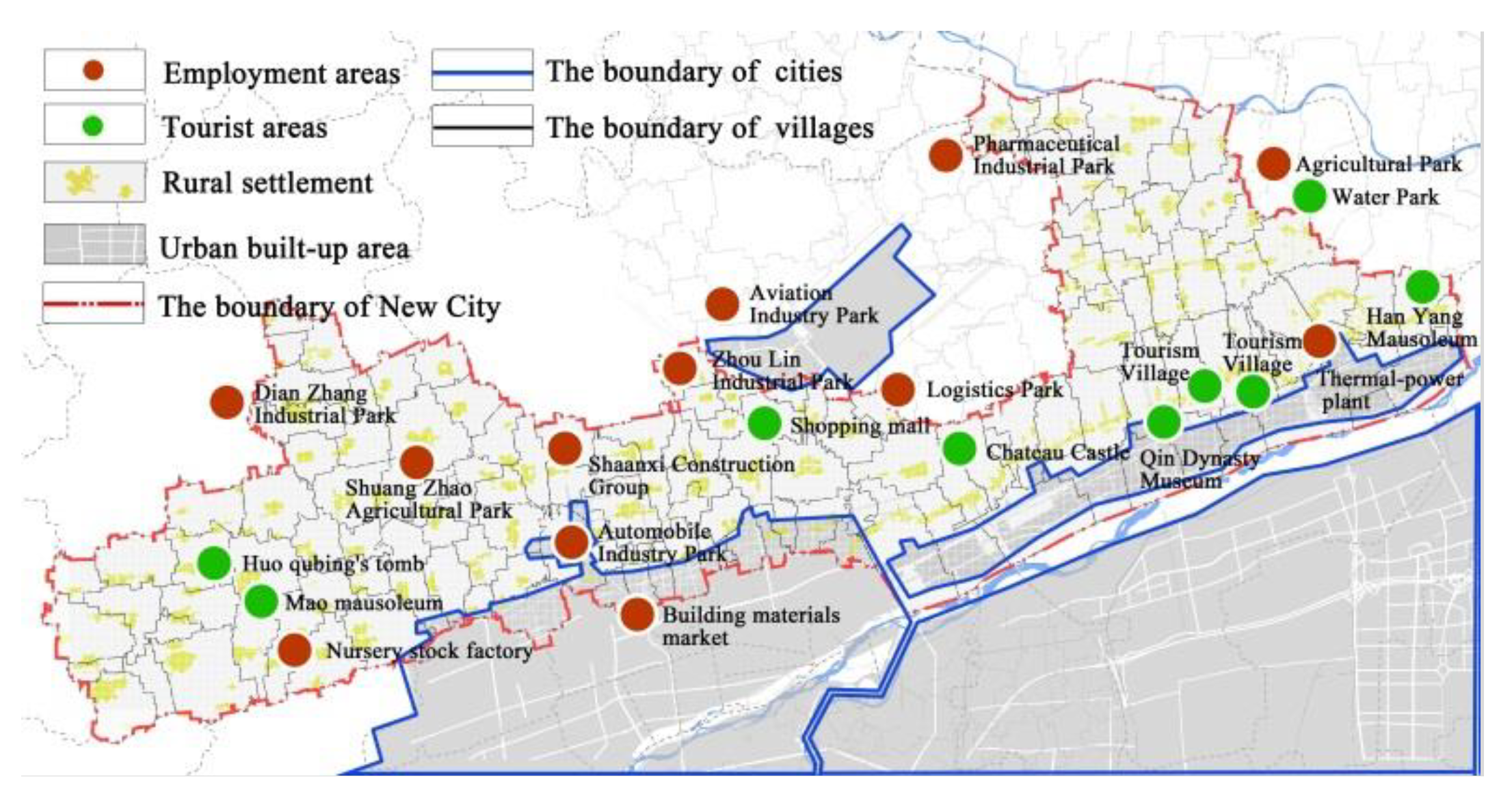
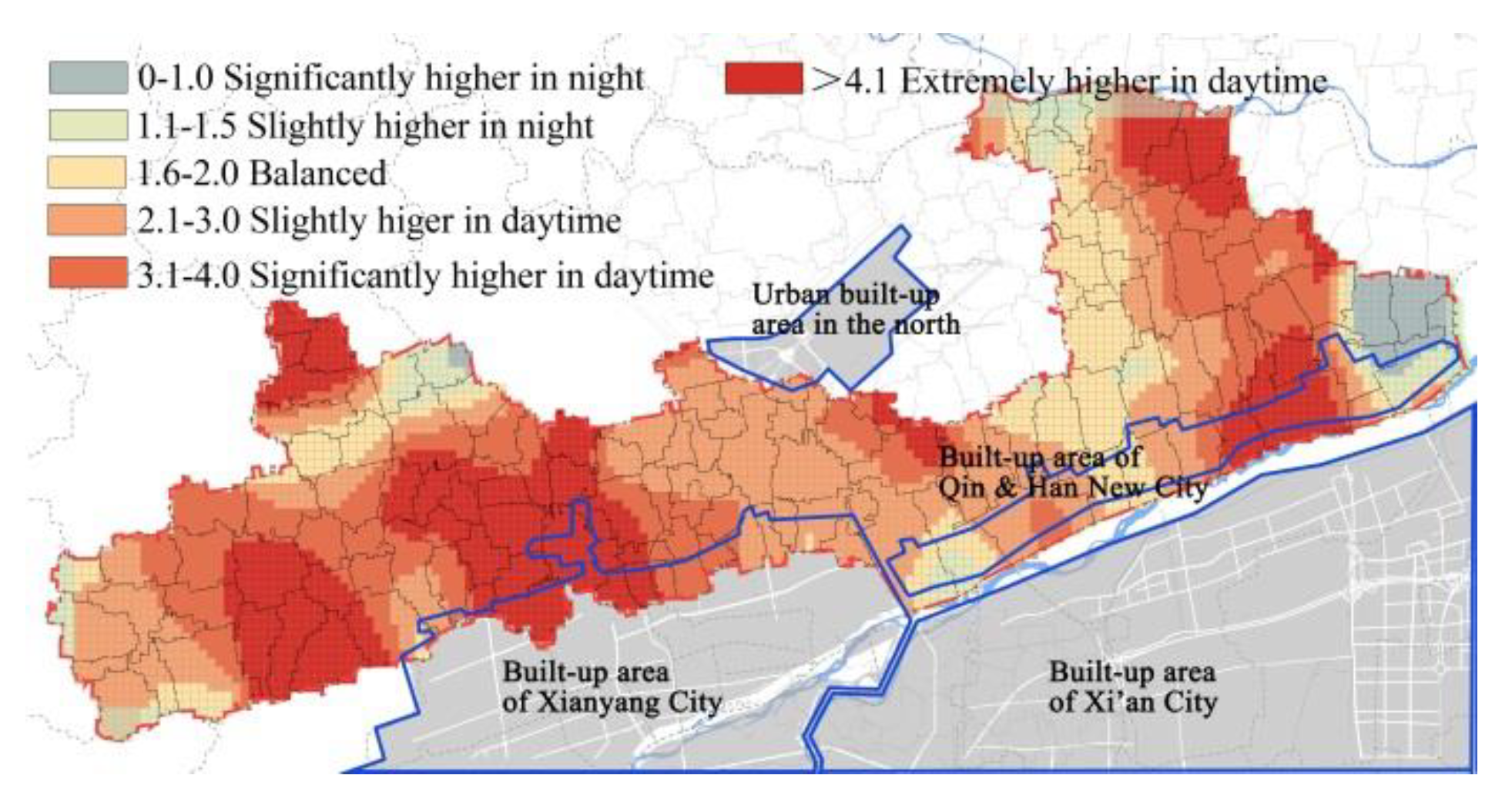
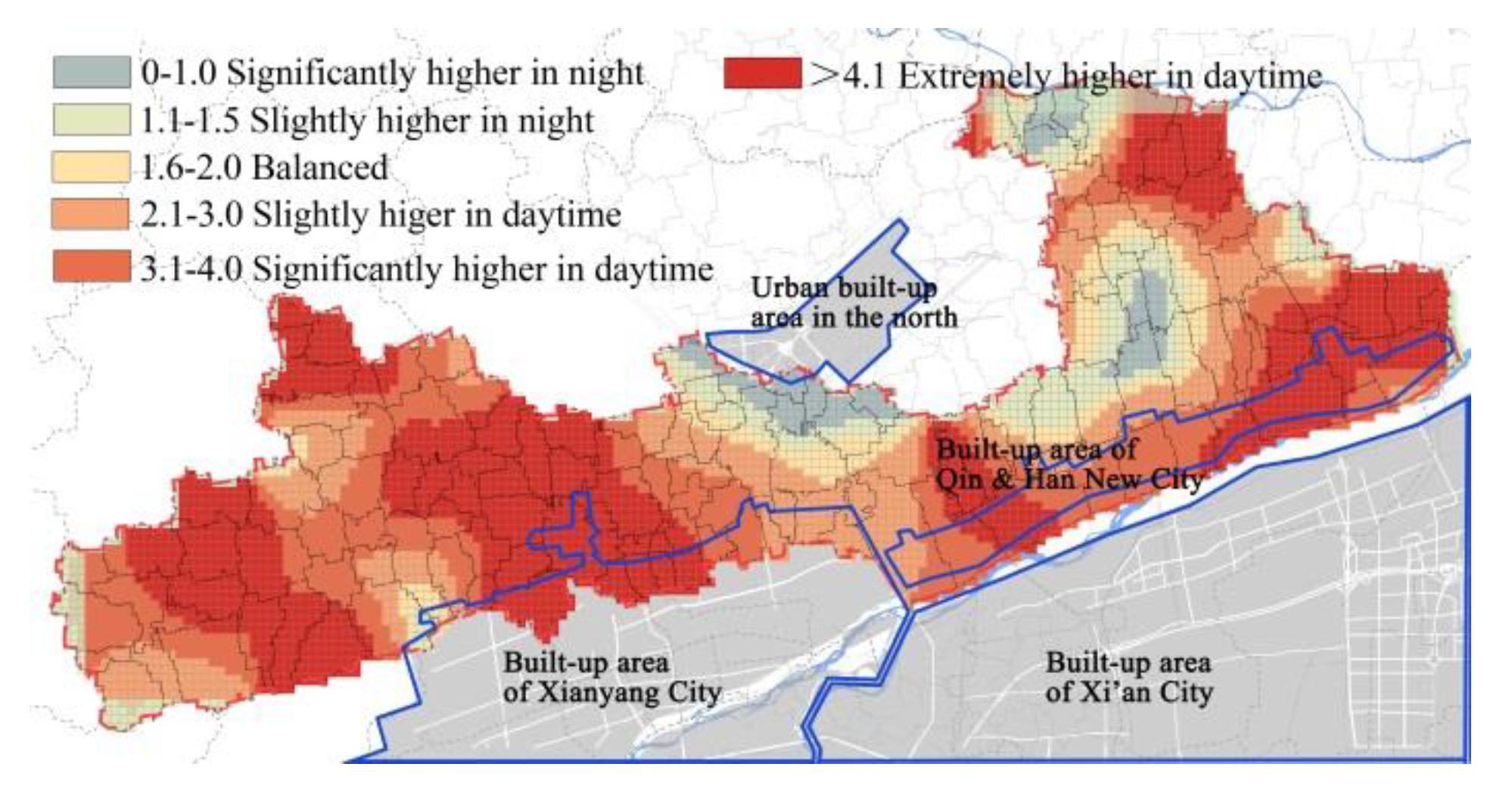

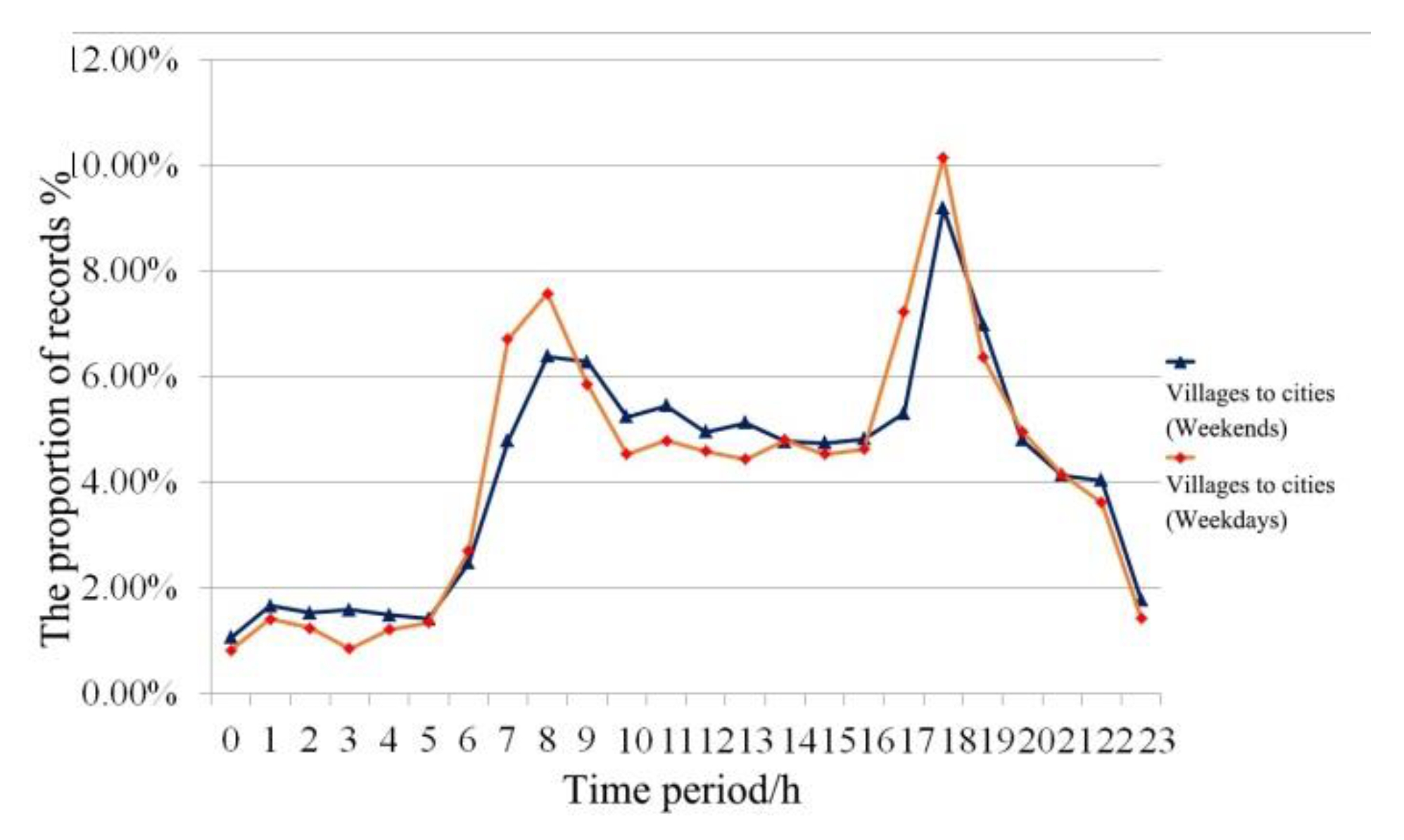
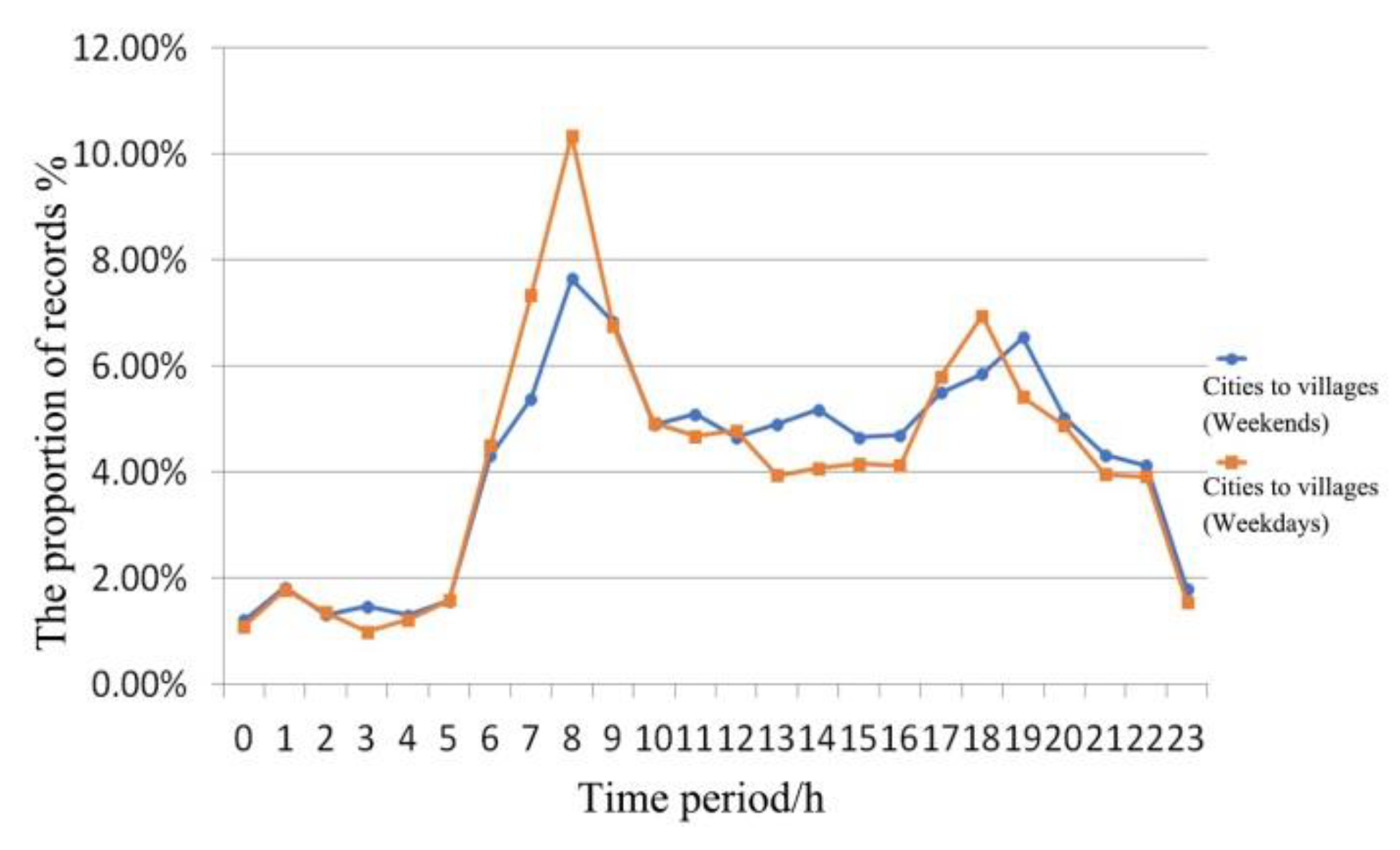
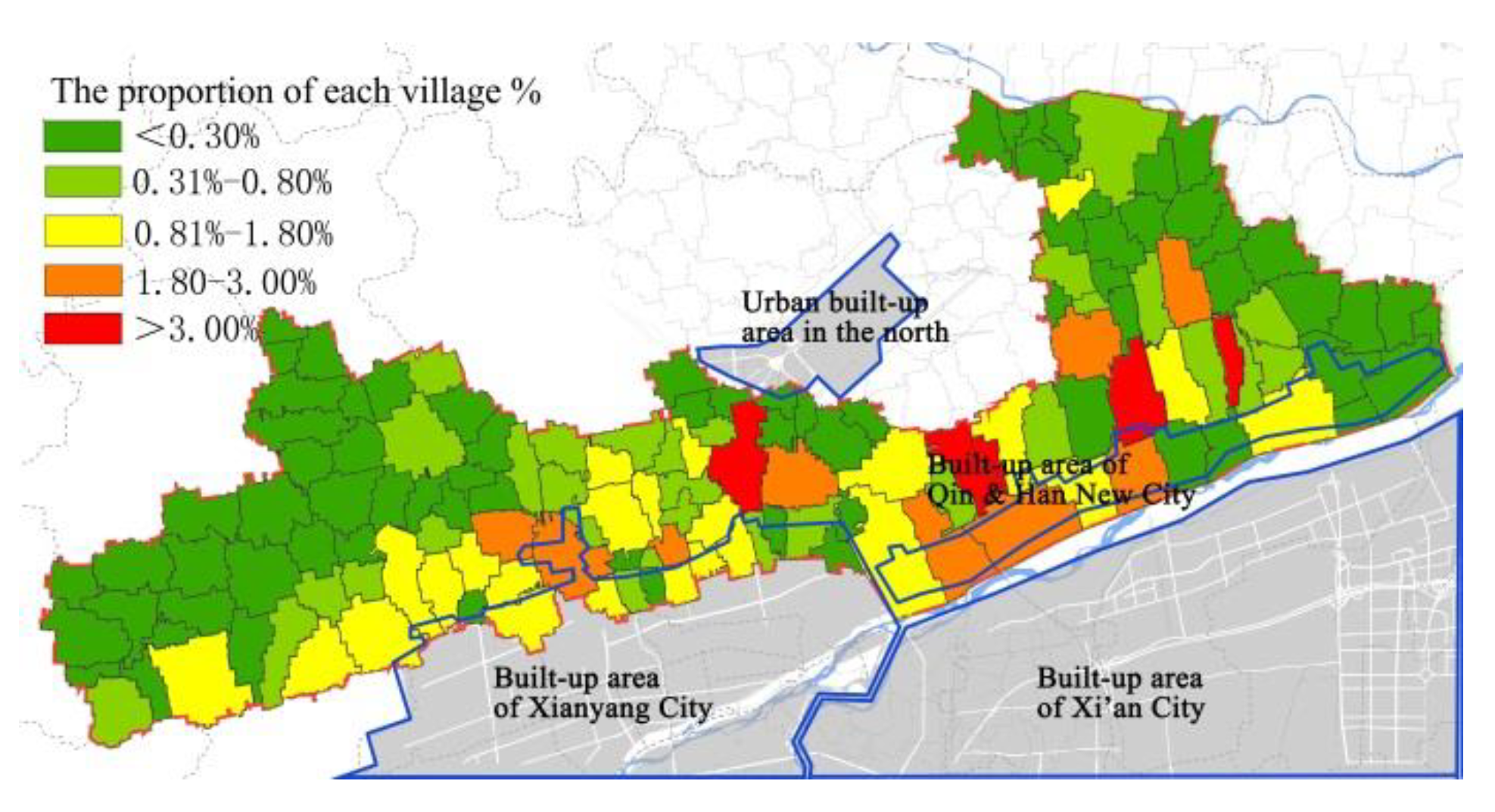
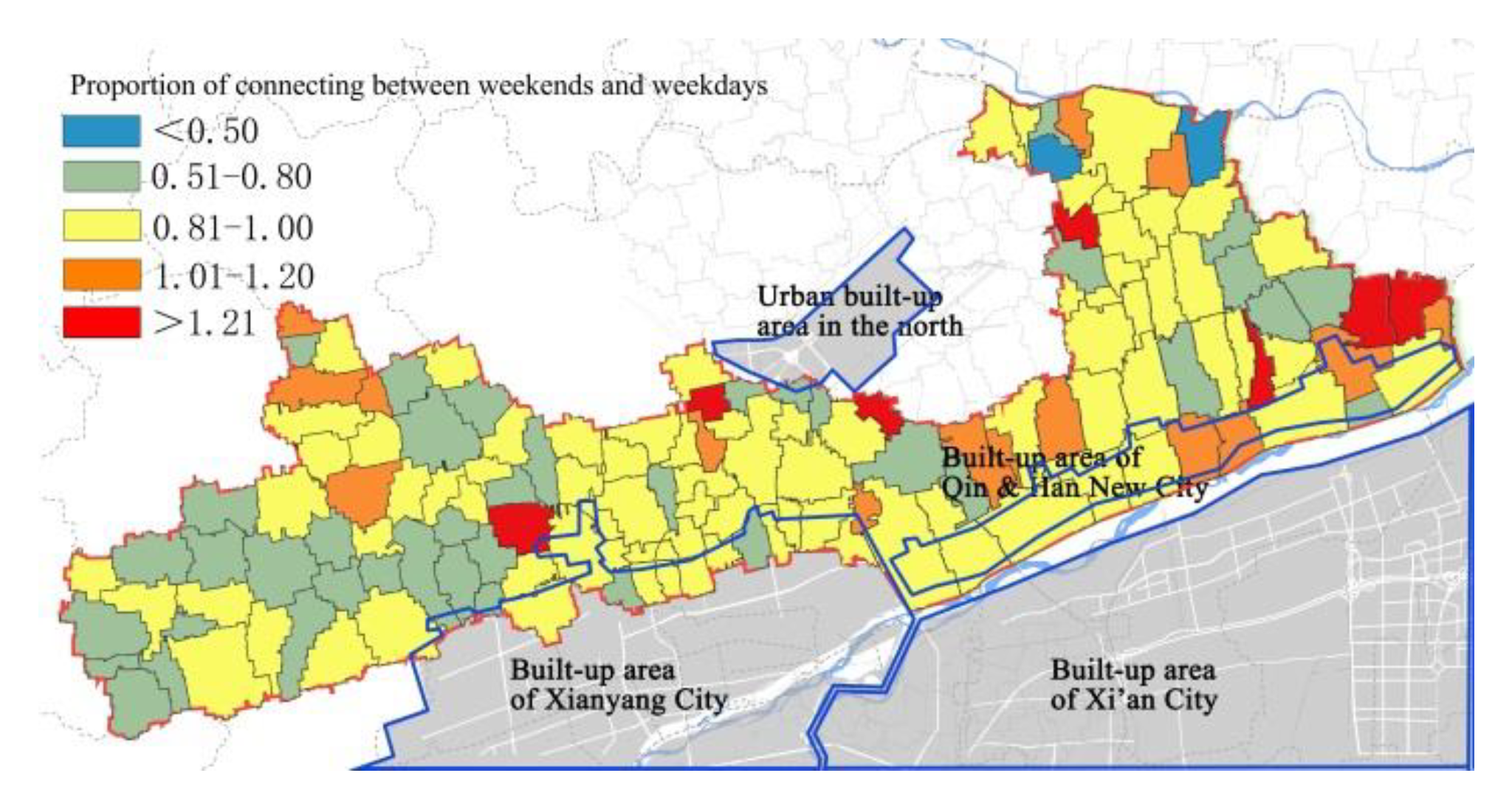
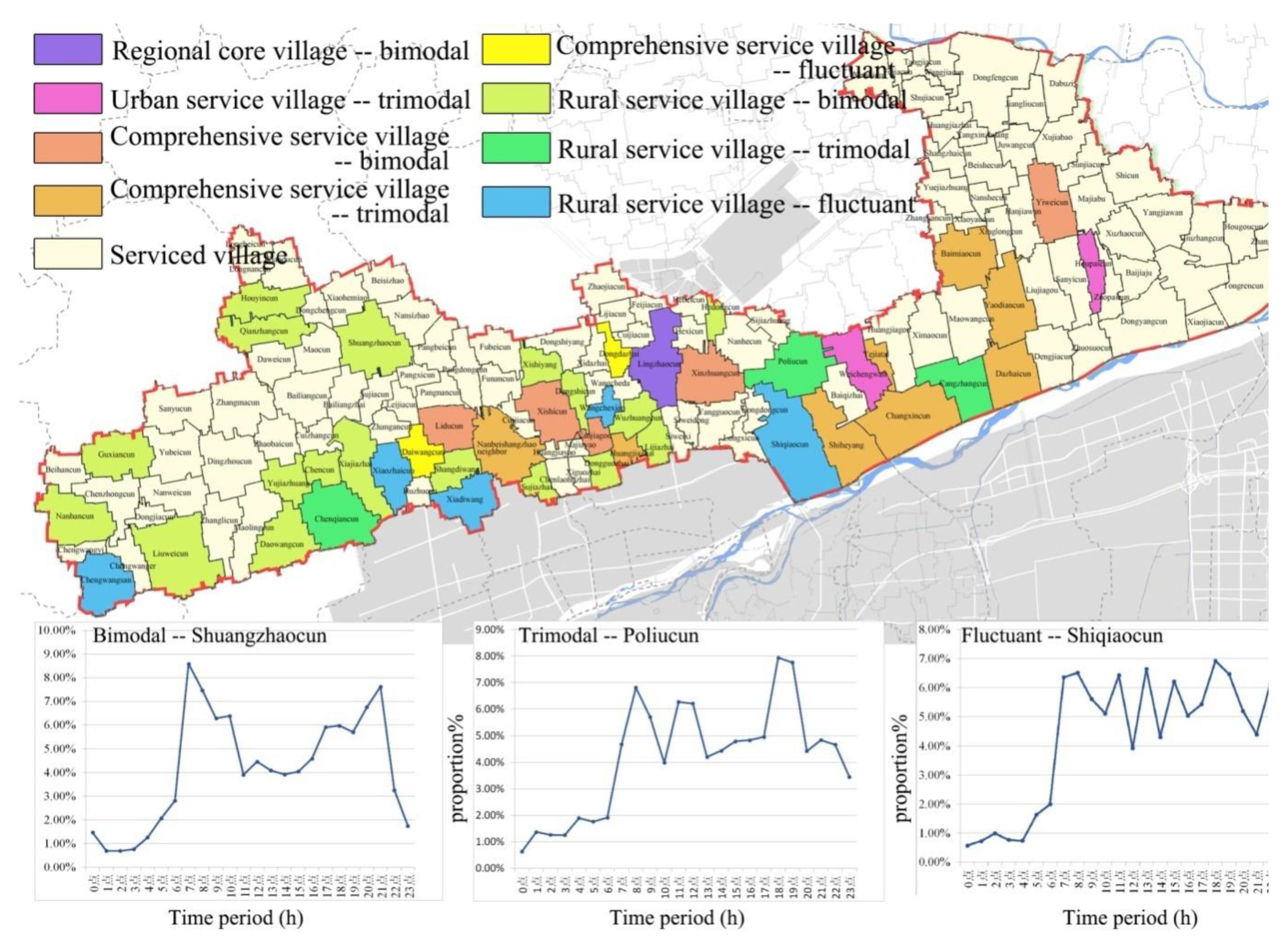
| Purpose | Registered Resident | Permanent Resident | Temporary Resident | The Largest Commuting Population Per Day |
|---|---|---|---|---|
| Population (thousand) | 221 | 265 | 51 | 59 |
| City | Age Composition (%) | ||||||
|---|---|---|---|---|---|---|---|
| <18 | 19–30 | 31–40 | 41–50 | 51–60 | 61–70 | >70 | |
| Xi’an | 3.92% | 34.37% | 23.53% | 15.29% | 8.66% | 3.61% | 1.17% |
| Xianyang | 4.83% | 30.60% | 22.00% | 18.01% | 9.25% | 4.11% | 1.55% |
| New City | 4.84% | 32.54% | 21.72% | 18.62% | 9.59% | 4.22% | 4.52% |
| Type | Connecting Intensity | Activity Curve | Distribution | Permanent Population | Proportion of Construction Land | Main Land Use Type | Leading Industry | Remark |
|---|---|---|---|---|---|---|---|---|
| Core village | Obviously strong with urban and rural areas | Bimodal | Suburban area | Moderate | Very high | Residential, commercial, public service | Commercial land service | Regional-level facilities |
| Urban service village | Strong with urban and weak with rural areas | Trimodal | The urban fringe area | Low | Very high | Residential, commercial | Service | Attractions around |
| Comprehensive service village | Strong with urban and rural areas | Bimodal | Suburban area | Moderate | Above average | Residential, industrial | Secondary industry | Characteristic industry |
| Trimodal | The urban fringe area | Moderate | Above average | Residential, commercial | Commercial land service | -- | ||
| Fluctuant | Suburban area | High | Average | Residential, public service | Agriculture, sideline | Some with resettlement | ||
| Rural service village | Strong with rural areas and weak with urban | Bimodal | Centre of outer suburbs, Suburban area | Moderate | Average | Residential | Agriculture, with a small amount of sideline and industry | -- |
| Trimodal | Suburban area | Moderate | Average | Residential, tourist service | Agriculture, with a small amount of accommodation | Attractions around | ||
| Fluctuant | Suburban area | High | Below average | Residential | Agriculture | -- | ||
| Serviced village | Weak with urban and rural areas | -- | Outer suburbs | Low | Very low | Residential | Agriculture | Lack of public services |
© 2019 by the authors. Licensee MDPI, Basel, Switzerland. This article is an open access article distributed under the terms and conditions of the Creative Commons Attribution (CC BY) license (http://creativecommons.org/licenses/by/4.0/).
Share and Cite
Zhou, J.; Hou, Q.; Dong, W. Spatial Characteristics of Population Activities in Suburban Villages Based on Cellphone Signaling Analysis. Sustainability 2019, 11, 2159. https://doi.org/10.3390/su11072159
Zhou J, Hou Q, Dong W. Spatial Characteristics of Population Activities in Suburban Villages Based on Cellphone Signaling Analysis. Sustainability. 2019; 11(7):2159. https://doi.org/10.3390/su11072159
Chicago/Turabian StyleZhou, Jizhe, Quanhua Hou, and Wentao Dong. 2019. "Spatial Characteristics of Population Activities in Suburban Villages Based on Cellphone Signaling Analysis" Sustainability 11, no. 7: 2159. https://doi.org/10.3390/su11072159
APA StyleZhou, J., Hou, Q., & Dong, W. (2019). Spatial Characteristics of Population Activities in Suburban Villages Based on Cellphone Signaling Analysis. Sustainability, 11(7), 2159. https://doi.org/10.3390/su11072159






